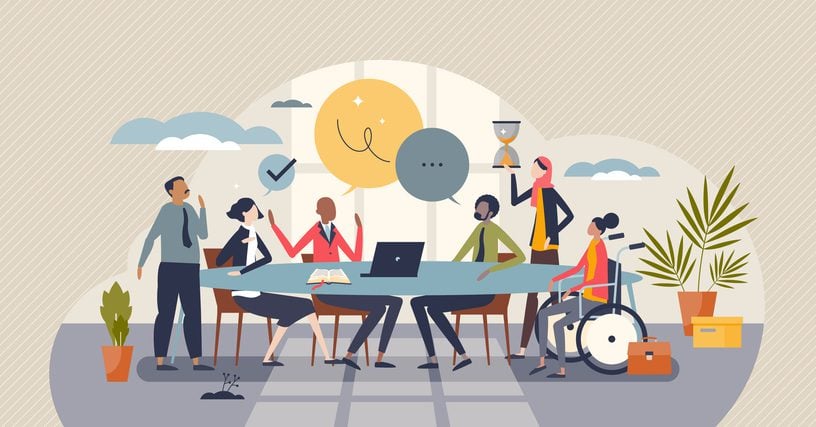Diversity, equity and inclusion (DEI) has been a hot topic of conversation for decades.
Regardless of what it is called, diversity, equity and inclusion (and belonging) has been around longer than many people may realize. The concept of diverse, equitable spaces where everyone feels welcome and has what they need to succeed dates back to the Civil Rights Movement, according to Andrew Adeniyi, founder and CEO of AAA Solutions, a DEI consulting firm.
But what really is DEI and who is it for?
“We started with affirmative action … then that morphed into diversity, and kind of this idea of ensuring that folks are getting equal opportunity,” Adeniyi said. “Over time, people realized that you can’t just have diversity, people have to feel included. So, you kind of got the ‘I’ that got attached, and then it went to DEI, realizing that there’s got to be equity in the conversation.”
With more than 10 years working in DEI spaces, Adeniyi said when DEI programs work well, businesses flourish — people are hired from previously untapped talent pools, innovation and creativity increases, companies maintain employees and consumers and avoid legal challenges and pay discrepancies.
Who actually benefits from DEI?
In short, everyone — or that is how it is supposed to work.
DEI is not just for women or people of color or members of the LBGTQ+ community. DEI ensures everyone has a right to live, work, go to school and play in diverse, equitable spaces where they feel included, said Devon Ginn, director of inclusion and community partnerships at the Indiana Repertory Theatre.
However, statistically, the demographic who benefitted the most from DEI in terms of education and corporate advancement, hired into positions of administration and executive leadership and involvement on boards was white women, according to Tasha Jones, Indy-based poet and author.
READ MORE: Indy-ology youth program unearths the stories of early Indianapolis
According to the 10th anniversary Women in the Workplace Report from 2024, white women hold nearly 19% of C-Suite positions, while women of color hold only 4% — a significant decrease from 2022 and 2021.
In Langston Hughes’ poem “Let America Be America Again,” he writes: “Let us pause a moment to resolve that we will never cease our stride until America has truly become a land of freedom, equality and liberty for all the sons of man.”
“That is really what diversity, equity and inclusion is about,” Jones added. “It is about being equitable, in the sense that there is [sic] still things in America that are just not fair, right?”
Why does this matter?
What it all boils down to is fairness.

“It’s not exclusively about workplace training or making quotas,” Ginn said. “It’s rooted in the broader civil and human rights movements; in centuries of activism for equity and justice. It’s a continuation of the fight for civil liberties and fair treatment for all people, especially marginalized folks in our communities.”
Diversity, equity and inclusion was never designed to address the material conditions of people in the margins, Ginn said. Instead, DEI programs and initiatives create environments where everyone not only has equal access to opportunities, but the tools they need to be successful — in and out of the workplace.
“DEI is often seen through that corporate lens, but quite frankly, it’s for every community and every institution,” Ginn said. “It benefits not just those who are traditionally excluded but also enriches the entire organization and societies by valuing those differences and celebrating those differences or lived experiences and perspectives.”
One of the biggest misconceptions about DEI work is that it is meant to exclude. However, data suggests America will be a majority minority country between 2040 and 2025, Adeniyi said.
“When you talk about why this matters, the world is diverse,” Adeniyi said. “Businesses are diverse. The talent pools are diverse, and customers and suppliers are diverse as well. So, if you’re not being intentional with this work it’s going to impact your ability to attract or retain talent.”
With DEI going away, what does this mean?
With DEI policies and programs being cut from federal and state agencies, universities and businesses, there has been a lot of fear circulating about what comes next.
“I think people who have been fighting for equity have been fighting for equity for a long time,” Jones said. “As soon as you figure out the rules — what it takes is diversity, what it takes is equity, what it takes is inclusion — then the rules change.”
Despite the risk, there may be institutions dedicated to continuing the work to create safe environments for their employees or students but under different languages.
“No matter what legislation says, this work will continue because DEI was never just a policy,” Ginn said. “It’s not even just a mindset. It’s a movement of communities, and it’s a movement for best practices in the workspace. And I think communities will keep finding ways to push for justice and equity through the lens of belonging.”
Contact Arts & Culture Reporter Chloe McGowan at 317-762-7848. Follow her on X @chloe_mcgowanxx.
Chloe McGowan is the Arts & Culture Reporter for the Indianapolis Recorder Newspaper. Originally from Columbus, OH, Chloe has a bachelor's in journalism from The Ohio State University. She is a former IndyStar Pulliam Fellow, and has previously worked for Indy Maven, The Lantern, and CityScene Media Group. In her free time, Chloe enjoys live theatre, reading, baking and keeping her plants alive.





